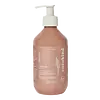What's inside
What's inside
 Key Ingredients
Key Ingredients

No key ingredients
 Benefits
Benefits

 Concerns
Concerns

 Ingredients Side-by-side
Ingredients Side-by-side

Water
Skin ConditioningGlycerin
HumectantCocos Nucifera Oil
MaskingCetearyl Alcohol
EmollientHelianthus Annuus Seed Oil
EmollientButyrospermum Parkii Butter
Skin ConditioningCetearyl Glucoside
EmulsifyingAspergillus/Rice Ferment Extract
HumectantPersea Gratissima Oil
Skin ConditioningStearic Acid
CleansingCaprylhydroxamic Acid
Ethylhexylglycerin
Skin ConditioningGlyceryl Caprylate
EmollientPolyacrylate Crosspolymer-6
Emulsion StabilisingSodium Phytate
Sodium Stearoyl Glutamate
CleansingMaltodextrin
AbsorbentWater, Glycerin, Cocos Nucifera Oil, Cetearyl Alcohol, Helianthus Annuus Seed Oil, Butyrospermum Parkii Butter, Cetearyl Glucoside, Aspergillus/Rice Ferment Extract, Persea Gratissima Oil, Stearic Acid, Caprylhydroxamic Acid, Ethylhexylglycerin, Glyceryl Caprylate, Polyacrylate Crosspolymer-6, Sodium Phytate, Sodium Stearoyl Glutamate, Maltodextrin
Helianthus Annuus Seed Oil
EmollientEthylhexyl Palmitate
EmollientStearic Acid
CleansingHelianthus Annuus Seed Wax
Skin ConditioningStearyl Behenate
EmollientPolyhydroxystearic Acid
EmulsifyingGlyceryl Stearate
EmollientSqualane
EmollientSilica Silylate
EmollientButyrospermum Parkii Butter
Skin ConditioningTocopheryl Acetate
AntioxidantCeramide NP
Skin ConditioningCeramide Ns
Skin ConditioningCeramide As
Skin ConditioningCeramide AP
Skin ConditioningCeramide EOP
Skin ConditioningCholesterol
EmollientHydrogenated Lecithin
Emulsifying2,3-Butanediol
HumectantCitric Acid
BufferingHelianthus Annuus Seed Oil, Ethylhexyl Palmitate, Stearic Acid, Helianthus Annuus Seed Wax, Stearyl Behenate, Polyhydroxystearic Acid, Glyceryl Stearate, Squalane, Silica Silylate, Butyrospermum Parkii Butter, Tocopheryl Acetate, Ceramide NP, Ceramide Ns, Ceramide As, Ceramide AP, Ceramide EOP, Cholesterol, Hydrogenated Lecithin, 2,3-Butanediol, Citric Acid
Alternatives
Ingredients Explained
These ingredients are found in both products.
Ingredients higher up in an ingredient list are typically present in a larger amount.
This ingredient is also known as shea butter. It is an effective skin hydrator and emollient.
Emollients help soothe and soften your skin. It does this by creating a protective film on your skin. This barrier helps trap moisture and keeps your skin hydrated. Emollients may be effective at treating dry or itchy skin.
Shea butter is rich in antioxidants. Antioxidants help fight free-radicals, or molecules that may harm the body. It is also full of fatty acids including stearic acid and linoleic acid. These acids help replenish the skin and keep skin moisturized.
While Shea Butter has an SPF rating of about 3-4, it is not a sunscreen replacement.
Shea butter may not be fungal acne safe. We recommend speaking with a professional if you have any concerns.
Learn more about Butyrospermum Parkii ButterHelianthus Annuus Seed Oil is the oil derived from the seeds of a Sunflower. Sunflower seed oil is non-fragrant. It is an emollient, meaning it helps to soften the skin.
Sunflower seed oil contains many fatty acids. The fatty acids found in sunflower seeds include (from highest amount to least): linoleic acid, myristic acid, palmitic acid, stearic acid, arachidic acid, oleic acid, and linolenic acid.
These fatty acids help the skin create ceramides. Ceramides play a role in repairing the skin barrier.
Helianthus Annuus Seed Oil helps moisturize the skin. This in turn helps the skin look more rejuvenated and smoother.
Sunflowers are rich in vitamin E.
Historians believe Indigenous cultures of North America domesticated sunflowers before corn. Thus they relied on sunflower oil for a variety of uses. One such use is moisturizing skin and hair.
Sunflower seed oil may not be fungal acne safe. We recommend speaking with a professional if you have any concerns.
Learn more about Helianthus Annuus Seed OilStearic Acid is a fatty acid. It is an emollient, emulsifier, and texture enhancer.
As an emollient, stearic acid helps soften skin. It aids the skin's protective barrier by preventing water loss. It also provides a gentle cleansing effect without stripping away natural oils.
Stearic acid may also be used to enhance the texture of products. It can add volume and stabilize ingredients such as water and oil. This can help water and oil ingredients from separating.
Sources of stearic acid include animal or vegetable fats/oils such as coconut or shea. It can be naturally found in butter, cocoa butter, shea butter, vegetable fats, and animal tallow.
This ingredient may not be Malassezia folliculitis, or fungal-acne safe.
Learn more about Stearic Acid